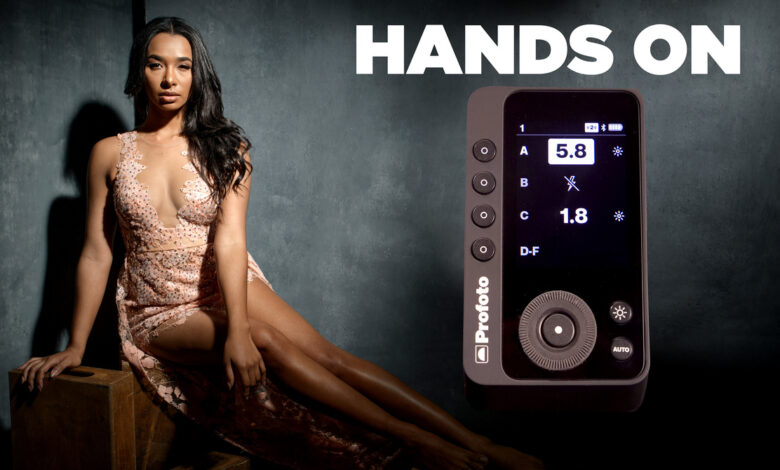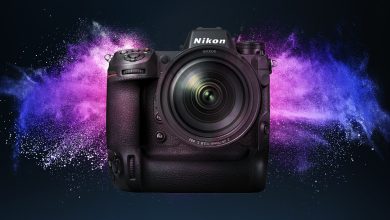Our Hands-On Preview of Profoto’s Connect Pro Flash Trigger

If you are a Profoto user who has always dreamed of the day you could see the actual power settings of your strobes directly on the remote, today, your dream has come true. I was one of the first photographers to test the new Connect Pro in my own studio, and I have to say, this is a very welcome upgrade for any Profoto user.
I’ve always been a big fan of Profoto and their lighting system. Maybe it was because all my photography idols used Profoto or maybe it was because their light modifiers were so easy to connect to a flash head compared to my Dynalites and later, my Paul C Buff lights. So, when the announcement came that their Air Remote system was being upgraded with the new Connect Pro radio trigger, a rather large smile came across my face, and my first words were, “finally!”
My first introduction to Profoto lights came when I picked up a pair for my wedding career maybe a decade ago. Back then, the trigger system was called the Air Remote Transceiver, and it worked very much like my half a dozen Pocket Wizard Plus II and III wireless remotes. Basically, with the original transceiver you had eight different channels and six different groups that you could control separately from the remote. Unlike my Pocket Wizards (and countless other wireless systems), the Profoto Air remote worked flawlessly and was the most reliable triggering system I had ever used, and it still is to this day. The biggest problem with that early remote was you couldn’t tell much about the state of your flashes. You couldn’t easily tell if a flash was on or off, what power level the flash was set to, and I don’t believe you could shoot past your camera’s native flash sync speed.
Then, a few years later, Profoto released their updated Air Remote TTL flash trigger, which finally allowed you to see which strobes were on, what relative power setting you were adjusting them to, and offered the ability to use hyper or high-speed sync with shutter speeds above 1/250th of a second. However, as big of an upgrade this flash trigger was to its predecessor, the TTL version still lacked the ability to show exactly what the flash level was set to on any given flash, and it also only allowed you to control three groups: A, B, and C. For many studio sessions, I actually preferred the older Air Transceiver and used the TTL Remote for on location shooting where I was typically only using one to two lights max.
Well, nearly eight years later, we finally have the Profoto Connect Pro remote. This remote boasts a lot of new upgrades that will surely be welcomed by seasoned Profoto users and new users alike. In the above video, you can see how I might use this remote in a real world photoshoot, but for this article, let me outline a few of the latest and greatest new features in this brand new remote.
Full Flash Output Display
Obviously, the greatest update in the Connect Pro is the ability to see the actual power setting on up to six different flash units. When you open the box, the Connect Pro comes preset to use the “classic” Air 1 option, which I guess is still useful for older non-Air X flashes. However, if you own any Profoto product that uses Air X like the B10(X), Pro-11 or C1 series, you can switch the Connect Pro over to Air 2, which changes your display from relative power to the actual power settings seen on the back of the flash itself.
This is great because now, you can easily see if your flash is close to firing at full power or if you want to build setups using specific flash ratios, you can see everything from right on top of your camera and make the adjustments accordingly.
Now Control Six Groups
Profoto remotes have always allowed you to control up to six individual groups, but none of the prior remotes let you control them as easily as the Connect Pro. Now, you can easily see groups A, B, and C all at once, but you can also quickly navigate to D, E, and F with the push of a button. With the prior Air TTL Remote, you could only view A, B, and C from the remote, and while the older Transceiver model allowed you to control all six groups quickly, you never knew what power levels any of the flashes were set to fire at when the shutter was clicked. Thankfully, this new interface is super helpful if you enjoy building multi-flash setups and want control over every single flash quickly and easily.
Improved Battery Life
The new Profoto Connect Pro uses 3 AAA batteries instead of 2 AAA found in previous flash triggers. Comparing it against the two older transmitters, the Connect Pro appears to stay powered for much longer than the previous remotes even when you factor in the extra battery. Profoto mentions that the Connect Pro can use lithium batteries, which hints that maybe there might be another battery upgrade in the future, but personally, I prefer having a remote that uses easily accessible AAA batteries in the event that they die in the middle of a shoot they can easily be replaced.
Easier to Update
Since Profoto’s Air X technology uses Bluetooth to connect the Connect Pro to your flashes and phone, it’s easier than ever to update your flash and trigger’s firmware anywhere you happen to be shooting. In the past, you had to plug each of your flash units into a computer to update the firmware, but now through the iOS Connect App, you can easily check the status of all of your devices and update them quickly and easily.
Access to 100 Wireless Channels
With more and more devices bogging down commonly used radio frequencies, having access to more radio channels has never been more important. The Connect Pro gives you access to 100 channels, which means you can easily avoid interference from other Profoto users at bigger events and workshops or crowded frequencies in larger urban settings. I do wish Profoto added some sort of radio traffic scanner to determine which channels are the most reliable with the least interference, much like my Sennheiser G4 wireless lav mic system offers. Maybe that is something they could add in the future.
Full TTL and Hi-Speed Sync Capabilities
Just like the older Air TTL remotes, the Connect Pro allows you to fire your flashes with auto TTL exposure. This means if you shoot dynamically changing scenes where you need your flash in TTL mode, you can still lock in your backlights into manual and get correct exposures. Likewise, if you enjoy shooting with shallow depth of field in bright sunlight, the Connect Pro will allow you to fire your strobes in Hi-Speed mode, which still gives you a correct exposure when your shutter speed is beyond your camera’s native shutter sync. Keep in mind, you will need the specific remote for your camera to guarantee both TTL and Hi-Speed Sync modes will work.
What Could Be Improved?
Two-Way Communication
I’ll admit, I’m not exactly sure if AirX relies on radio or Bluetooth or a combination of the two. But from my initial tests, it appears that the Connect Pro remote only sends signals to the flashes but can’t receive them. The reason I speculate this is because if you manually turn on the modeling lamp on a strobe or change the power setting directly from the back of the flash, the new settings do not update on the remote. I found myself taking video clips with the B10x’s modeling lamp only to find them sporadically turning themselves off when I woke the remote up from the sleep mode. This threw me off for a while until I realized what was happening. This might seem like a small thing to even bring up, but in a perfectly seamless system, I’d expect each flash and each trigger to know the settings from both directions.
One Flash, Multiple Photographers
Another consequence of the above issue could be an issue for event photographers who rely on sharing strobes with multiple photographers. Keep in mind, I only have one Connect Pro, but I do have multiple Air TTL and Transceivers. If you want to control one light with multiple cameras (or multiple lights with multiple cameras), it does get a bit confusing trying to know exactly what flash exposure your camera will receive when triggered. Maybe if I had two AirX remotes to further test this, perhaps the two remotes would update the correct power setting in real-time depending on who changed the exposure, but if you plan to use multiple different remotes, like a few Connect Pros and some older Air Remotes, it’s going to give you nothing but issues. On that note, the remote only works entirely in Air 1 (classic) mode or Air 2 (new) mode. This means if you want to use older non AirX flashes, you will have to resort to the older Air 1 mode that doesn’t show the full power setting. You can’t mix and match some AirX and non AirX flashes on have both Air1 and Air2 options at the same time based on their hardware limitations (at least not yet).
I’m curious to see how multiple Connect Pros interact with each other on the same channel and same group. Sharing a single flash or two with an assistant for wedding receptions was a big part of my wedding photography system, and it would be a bummer if the Connect Pro didn’t make that process easier with all this new technology. Maybe there could be a way to lock each remote’s setting so your output level is exactly what you expect, not what your assistant just changed it to.
Lack of Physical Ports and Advanced Features
The final little improvement I would love to see in these remotes (and other brands’ remotes too frankly) would be adding more advanced features for advanced photographers. Ideally, for me at least, my flash’s wireless trigger could be used for also triggering the camera. If you’ve ever done sports photography with remote cameras or setup photobooths at weddings and want your guests to trigger the camera with a remote, you know how nice it is having everything built into one system. For me, this all-in-one trigger system used to be found with Pocket Wizards. Even when I switched over and bought Profoto flashes and a few Transceiver remotes, I was still able to use the PC Sync ports built into the trigger to fire my camera remotely if I wanted to (with the Nikon 8pin cable). Of course, you need two triggers to do this, but most of us are going to buy two remotes for backup and redundancy anyway. Many newer cameras like the Sony A7 series use USB-C or USB Mini ports to trigger the shutter, so it would be nice if the Connect Pro had a few extra ports for those of us who like to do more advanced camera triggering.
Speaking of USB-C ports, one thing I’ve really come to enjoy with a lot of my newer photography gear is the ability to simply plug a camera or other battery-operated device into a USB-C charger and have the batteries inside the device charge without having to take each battery out. Since the Connect Pro uses 3 AAA batteries, it would a lot more convenient to have a single USB-C plug that could charge all three batteries at once without having to open the back battery tab and remove all the batteries.
Next, let’s talk about features offered through software. A year ago, Lee Morris reviewed the new Pocket Wizards Raven Trigger, which is perhaps the most advanced trigger system ever made. It has a lot of cool features, like the ability to fire multiple flash brands and also works universally with multiple cameras despite them having different hotshoe configurations. The Raven also does some pretty nifty timing modes that the old Pocket Wizard Multi Max trigger could do too. One of those timing modes lets you delay the flash signal so you can take images back to back with different groups firing on different frames (sometimes called Alt Mask, or Freemask mode). Essentially, with a fast enough frame rate, you can capture the exactly same moment with different lights firing to produce a cool effect. It would be fantastic if Profoto’s most advanced triggering remote could also give you some of those options as well to open up even more creativity (think Jeremy Cowart’s Lightograph technique). I know not every feature can be crammed into a single product, but perhaps Profoto could open up some of these more advanced syncing tools even if it meant photographers had to use a separate desktop editor or the iPhone Connect app to access them.
Finally, I would love to see control of every aspect of the flash from the remote. Right now, you can turn on the modeling lamps, but you cannot control the power of the modeling lamps or control the color temperature of the lights. If your modeling lamps are set to proportional, you can’t switch them to free mode. You also cannot turn off the flash entirely at the end of a shoot; you can only put the head into sleep mode. At the moment, you also can’t switch the flashes between Freeze and Normal mode from the remote, nor can you turn on or off the optical slave mode. Some of these settings don’t seem that important, but since the Connect Pro has such a nice user interface (the best I’ve ever seen on a wireless trigger yet), it would be great to be able to control everything right from the remote especially if your flashes are mounted far out of reach.
Conclusion
At the end of the day, I really think Profoto knocked it out of the park with this remote. It’s clearly the sleekest remote I’ve ever used, the user interface is super easy to use and navigate, the LCD screen is better than any other triggering system just like the B10(x) screen against its competitors, the battery life is outstanding, and the reliability of triggering your flash has never failed me. If you are a Profoto user, this is a no-brainer upgrade. Just make sure you purchase the correct version for your camera if you want to use the TTL and Hi-Speed Sync modes.




